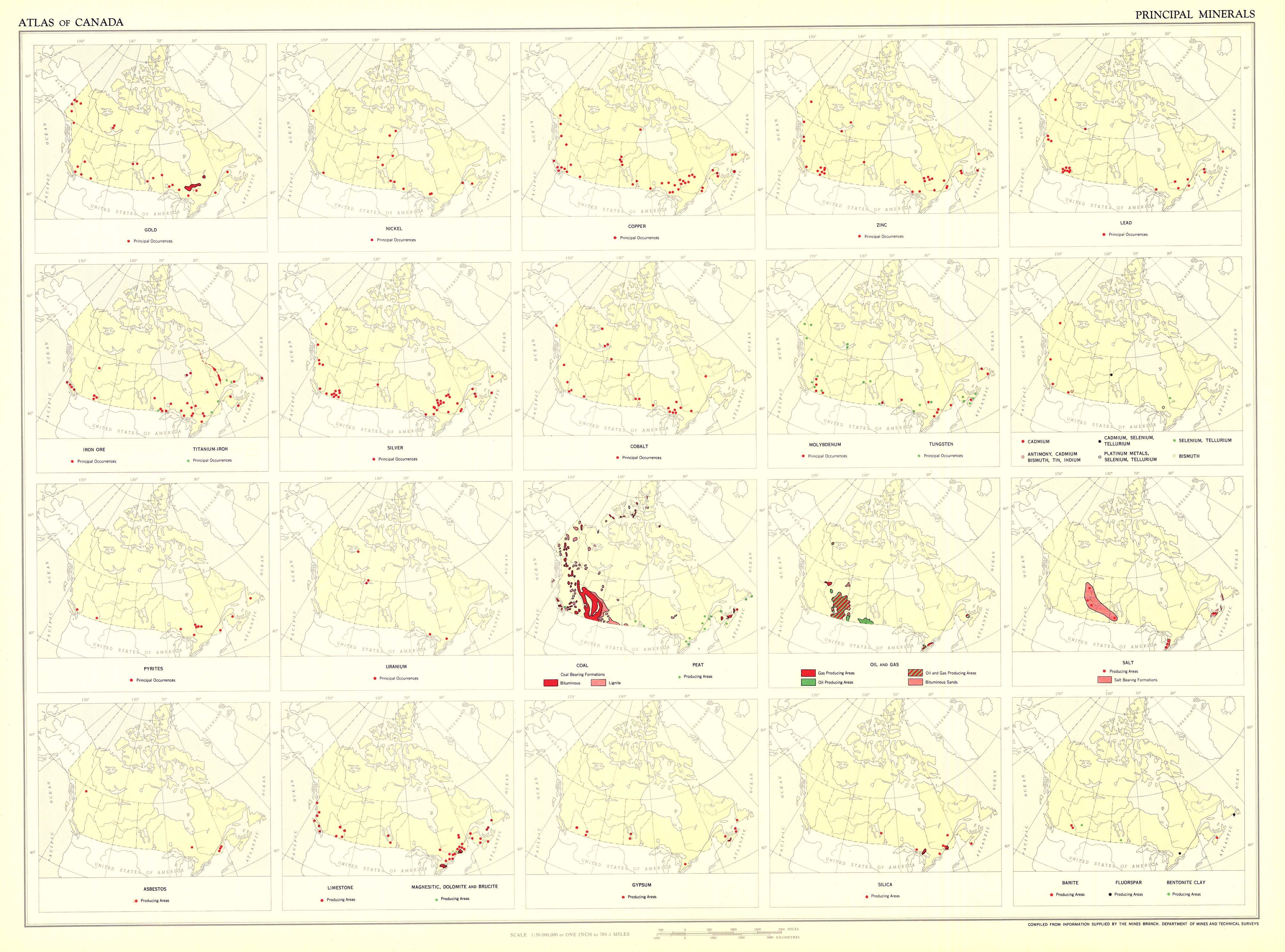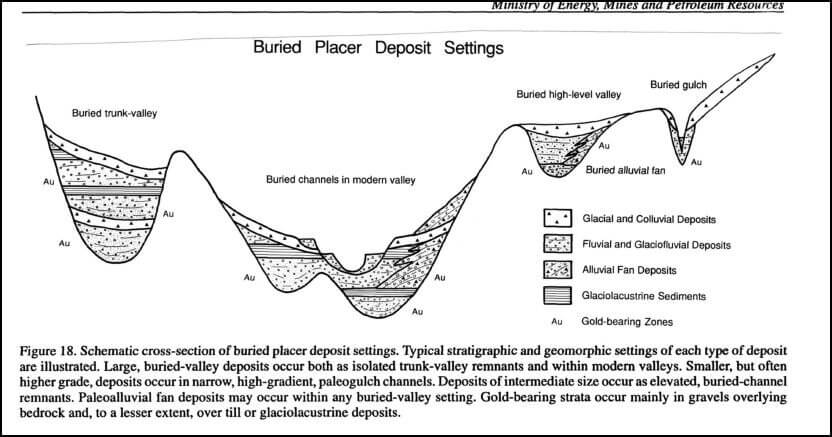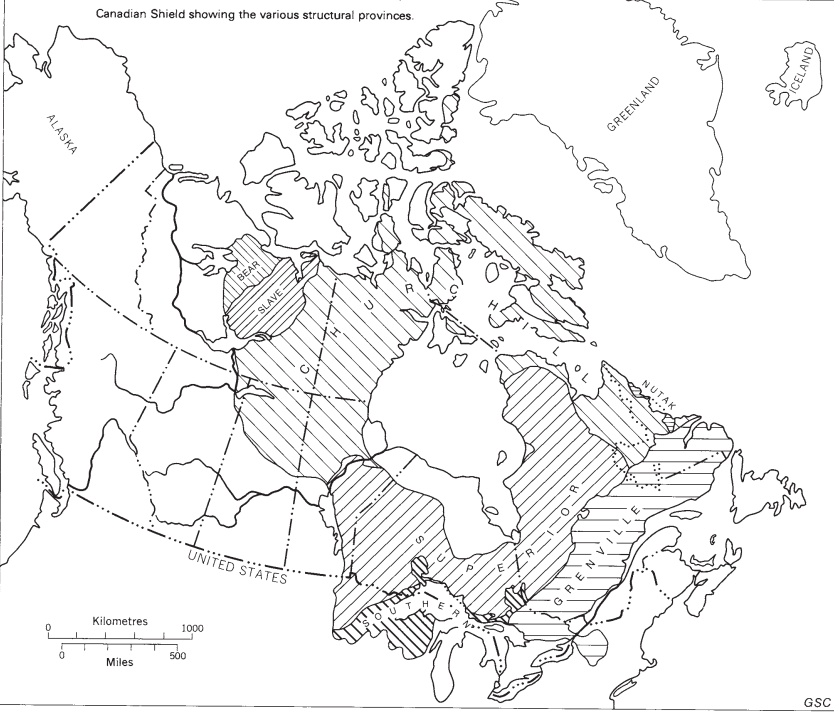Table of Contents
- Placer Gold
- Panning
- Origin of Placers
- Minerals Associated with Gold
- Occurrence of Placers
- Gold in Conglomerate
- Gold Veins and Other Gold Deposits
- Where to Find Gold in Ontario
- Where to Find Gold in Quebec, Nova Scotia, and Manitoba
- Where to Find Gold in BC & NWT
- Alterations in Rocks
- Mineralization
- Panning for Gold
- Where to Find Platinum
Placer Gold
Placer deposits of gold are formed by the concentration of the gold from the debris of gold veins and other deposits of gold in rock. As the loose material is washed down hillsides into gullies and valleys, the gold, being six or seven times as heavy as quartz and other rock- minerals, quickly works its way to the bottom of the moving mass and stays there. The larger nuggets may lodge in crevices and behind ledges; but if the slope is steep, everything loose is moved forward until it reaches a gentler descent, which is likely to be the mouth of a gully where it joins the main valley. There the gold is deposited on bedrock, or perhaps on a hard clayey bottom. The pay streaks would be found along the gulch and at the junction with the larger valley.
Panning
Panning is the prospector’s method in searching for placers; it is an art requiring practice. Though it can not be learned from a book, a hint as to gold “colors” may be useful. Although the particles of gold are hammered so thin in their passage downwards that it may take one or two thousand of them to make the value of one cent, each of these small “colors” may be easily visible. So a good long “tail” making a brilliant show, might be worth only one twentieth or one fiftieth of a cent. But when the prospector attains skill in estimating the value of the “tail,” panning becomes his best helper in hunting for gold in veins and placers.
Origin of Placers
The important gold placers are the result of long periods of erosion. Changes of level may have drained away the original streams, or the streams may have worn down their beds, leaving the placers high up on benches. Changes of level sometimes lead to a further concentration of the gold by a stream that cuts down an old gravel deposit. This re-concentration, repeated again and again, accounts for some extra- ordinarily rich placers that have been found. It should be remembered that while this is going on, the rock material is being ground down, so that only the hardest survives in any quantity; this is commonly quartz and quartzite.
Sorting by wave-action has sometimes formed gold placers, such as the beach placers at Nome, Alaska, where the prospector had a good guide in another heavy mineral, red garnet, (locally called “ruby”), concentrated along with the gold, and showing very conspicuously.
Placer gold may often be followed back to its source in the rocks, and this sometimes leads to valuable discoveries. Small placers sometimes occur near gold veins, having been formed by recent weathering in a glaciated country like Ontario or Quebec. They should be looked upon as surface enrichments, which have moved a short distance from their source, and as not likely to be of much extent or value. But there may be places where it would pay to work these recent placers in a small way.
Minerals Associated with Gold
Heavy hard minerals that concentrate with the gold are often a guide. The commonest are magnetite and ilmenite (or “black sand”), garnet (or “ruby sand”), zircon (or “white sand”), and monazite (or “yellow sand”). Tinstone is often found in gold placers, and may be a valuable by-product. Platinum (gray) and osmiridium (silvery) should not be overlooked; they are more valuable than gold.
Occurrence of Placers
It is a good rule to look for gold veins in placer regions; but the prospector should remember that valuable placers may have been formed from deposits too lean to work, and also that erosion may have completely removed the vein. On the other hand, some first rate gold ore has its metal so finely divided that it does not concentrate, but washes away. Such ore, when set free by erosion would not form a placer.
In glaciated regions, placers may have been scattered by the ice-action; or, as at Cedar Creek, B. C., the placer may have been left undisturbed, but covered with glacial gravel. In the Cariboo district, this covering is so deep in some parts that valuable placers long escaped discovery. While the time since the close of the glacial period has been too short for the formation of important placers by erosion, some payable placers have been formed by re-sorting of the gravels that have been scattered by the glaciers.
Gold placers have sometimes been buried by lava flows, as in Australia and California. In gold districts, the beds and valleys of streams that have cut down through lava flows of the later geological eras, should be carefully examined.
Gold in Conglomerate
As might be expected, conglomerate occasionally contains gold nuggets, representing old placers; this is a suggested explanation of the South African gold fields; but the gold may have been deposited by circulating solutions, after consolidation of the conglomerate. An interesting case of an old placer now converted into conglomerate is found in the Black Hills, South Dakota, where basal conglomerate of the Cambrian age lies unconformably on pre-Cambrian schists and gold-bearing quartz veins, the erosion of which supplied the material for the ancient placer. In some places, this conglomerate has the rounded grains of gold that are characteristic of placers. Several paying mines have been worked in this rock.
Gold Veins and Other Gold Deposits
Nearly all workable gold deposits (except placers) are veins, lodes, shear zones, stock works, saddle reefs, and replacement ore-bodies, which are connected with intrusions of granite, syenite, diorite, and other igneous rocks of an acid or intermediate variety. It is said that about 80% of the world’s profitable gold mines are closely associated with acid and intermediate porphyries.
Country Rocks
Gold deposits are found in a great variety of rocks; but, as might be expected from the close connection with igneous intrusions, the most favorable rocks are of the metamorphic kind, particularly mica schist, quartzite, and slate. Limestone is not as favorable; but some of the BC copper-gold deposits are in limestone.

Where to Find Gold in Ontario
In Ontario gold has been found with mispickel in quartz veins in schists near intrusive granite (Deloro); with pyrite, bismuthinite, and magnetite in quartz veins in crystalline limestone (Frontenac); with pyrite, pyrrhotite, copper pyrites and galena, in quartz veins in a zone of chlorite schist in a mass of gabbro, which is cut by many granite dikes (Belmont); with pyrite, copper pyrites, and galena, in quartz veins in an altered sheared granite, protogine (Mine Centre); with pyrite in quartz lenses in gneiss (Sultana, Lake of the Woods); in veins in schist near intrusive masses of granite (various parts of Western Ontario) ; with pyrite, copper pyrites, bismuthinite, and molybdenite in a quartz vein cutting through a granite intrusion in trap, the trap being largely altered to schist (Mikado, Lake of the Woods); with pyrite, copper pyrites, zinc blende, galena, scheelite, graphite, calcite, dolomite, sericite, and chlorite in a system of quartz veins roughly parallel, in gray sericite schist near intrusive quartz porphyry (Hollinger, Porcupine); with pyrite, copper pyrites, molybdenite, graphite, tellurides, calcite, ankerite, chlorite, and sericite, in shattered quartz veins and feldspar-porphyry in Timiskaming conglomerate and graywacke, and in feldspar-porphyry, near intrusions of lamprophyre, granite, and porphyry (Kirkland Lake); with pyrite, ankerite, feldspar and sericite, in zones of porphyry and schist (altered basalt) traversed by small veins and veinlets of quartz (Matachewan Gold Mines) ; with pyrite, copper pyrites, zinc blende, tourmaline, bornite, and pyrrhotite in quartz veins in volcanic flows near granite and porphyry intrusions (Goudreau); with pyrite, copper pyrites, pyrrhotite, galena, mispickel, tellurides, and talc, in quartz veins cutting porphyritic syenite and chlorite schist near intrusive granite (Schreiber). Numerous discoveries have been made in the District of Patricia around Red Lake, Woman Lake, Narrow Lake, Clearwater Lake, etc., forming an east and west mineral belt about 150 miles long. The producing gold mines of Ontario are in Timiskaming and Keewatin formations, near intrusions of granite, syenite, and porphyry. It is believed that the best field for prospecting is around the smaller bodies of granite, etc., which show more or less of the porphyry texture.
Where to Find Gold in Quebec, Nova Scotia, and Manitoba
Northern Quebec, where it borders on Ontario, has the same general geology as that part of Ontario. Several gold mines have been established in Rouyn and adjoining townships. Geological surveys have shown the existence of a belt of sedimentary rocks of the same age as the Timiskaming in Ontario. The discoveries have been made where these rocks are intruded by Algoman granite, or near such intrusions. The belt is about 120 miles long, and is apparently a continuation of that in which the Kirkland Lake area lies. In the Val d’Or district, gold has been found with pyrite, copper pyrites, zinc blende, galena, stibnite, scheelite, and tourmaline (abundant), in quartz veins in granodiorite, quartz porphyry, green schist, and syenite. The quartz is shattered, and the gold values are deposited in the cracks. In Rouyn and adjoining townships, large bodies of copper pyrites have been found containing important quantities of gold. A good deal of placer gold has been taken from the Chaudiére River and its tributaries south of the St. Lawrence, partly from gravel that had not been disturbed by the great glacier. There may be other places like this in eastern Canada.
In Nova Scotia, the ore is in saddle reefs, in anticlines of folded quartzite and slate at places where crossfolds cause a dome shape. These rocks, of preCambrian age, are cut by bodies of granite of Devonian age. The veins are very numerous, and lie mostly in the slate close to quartzite. They follow the strike of the sedimentary rocks. Most of the veins are interbedded with the sedimentary rocks, but some important ones cut across the strata. The gangue is mostly quartz, with some calcite, and the chief minerals are pyrite, mispickel, and galena.
In Manitoba, gold deposits have been found in Keewatin greenstone, schist, and volcanic rocks near granite intrusions. The Red Lake gold range, in Ontario, is continued westward in Manitoba. Northwest of Lake Winnipeg, a gold range begins at Wekusko Lake, and continues westward to and into Saskatchewan. The gold is found mostly in quartz veins in the neighborhood of intrusions of granite. Tourmaline is abundant. Mispickel, pyrite, copper pyrites, galena, and zinc blende, are the accompanying minerals.
Where to Find Gold in BC & NWT
In British Columbia, the gold veins occur in replacement deposits at or near contacts of metamorphic with dioritic igneous rocks, the gangue being garnet, epidote, calcite, etc., and the “minerals” mispickel, pyrite and copper pyrites (Hedley); in quartz fissure veins in phyllite, (a rock intermedíate between slate and mica schist), (Lardeau); in quartz veins and schisted diabase (Poplar Creek); with copper ores in large replacement deposits in tuff and limestone near grano-diorite (granite-diorite) and syenite (Boundary) ; with copper ores in veins or replacement deposits in a porphyritic rock (augite-porphyrite) near bodies of granodiorite and syenite (Rossland); with copper ores in shear zones at or near contact of monzonite, (a rock intermediate between diorite and syenite) with sedimentary rocks (Princeton); with copper ores in mineralized zones in quartz-sericite schist (Britannia mine, Howe Sound); with copper ore in lenses in schist (Vancouver Island); with copper ore in replacement deposits in limestone near granite contact (Texada Island); with pyrite, limonite, native antimony, and tellurides in quartz veins cutting shale, slate, and graywacke of brown and greenish colors (Engineer mine, Atlin); with pyrite, copper pyrites, zinc blende, galena, tetrahedrite, native silver, argentite, etc., in quartz veins and wall rock replacements at contact between quartz porphyry and andesite tuff, and partly in the quartz porphyry, gold and silver values being about equal (Premier mine, Cassiar).
In the Northwest Territories gold has been found in widespread areas. The geological association is much like that in northern Quebec, Ontario, and Manitoba. It is so far away from these provinces that the rocks are given different names; but they are much the same in appearance and nature. The gold occurs mainly in veins and mineralized shear zones in sediments of Timiskaming type and in volcanics of Keewatin type. The favourable localities are at or near the contact with the smaller bodies of intrusive granitic rocks. Occasionally, as at the Box mine on Lake Athabasca (Saskatchewan) the gold is right in the granite. The Yellowknife gold camp on Great Slave Lake is the principal producing area. “Most of the gold deposits are auriferous quartz veins or quartz bodies associated with a little schist or other altered wall rock, and in most instances contain not more than about 1 percent of such minerals as pyrite, galena, sphalerite, chalcopyrite, and arsenopyrite. Visible gold is common.”
Alterations in Rocks
The neighborhood of igneous intrusive rocks is characteristic of all the gold-bearing deposits above mentioned. The country rocks near the ore deposits are usually altered in a noticeable way, which must be studied in each district. Some of the changes are schisting, fracturing, rusty appearance from weathering of disseminated pyrite, bleaching of dark rocks, the occurrence of calcite and other carbonates, and the appearance of minerals characteristic of contact metamorphism, such as garnet and epidote. Of these appearances, probably schisting and extensive mineralization with pyrite, or the rusty capping resulting from its weathering, are the most useful guides to the prospector.
Mineralization
The commonest mineral is pyrite. In Ontario, where banded iron formation is so common, prospectors may be led to waste time over the siliceous bands, often highly mineralized with pyrite, but usually barren of gold. Still, the gold mines of the Longlac area are in a banded iron formation that has been much folded and shattered, the gold being in veinlets of secondary quartz. Copper pyrites is next in importance as a mineralization; and, as it is of value in itself, where it is plentiful, and may make a copper mine, it should be assayed for both copper and gold. However, much copper pyrites in a gold ore causes difficulties in extraction with cyanide. Other minerals found in gold deposits are galena, zinc blende, mispickel, stibnite, bismuthinite, and the sulphur-arsenic and sulphur-antimony compounds of lead and copper; also molybdenite, and pyrrhotite. In some districts, tellurides are the important minerals accompanying the gold, and gold tellurides may be the chief or even the only gold minerals. All soft minerals of metallic luster, and of a silvery or lead-gray or yellow color, should be tested. The manganese minerals rhodochrosite and rhodonite are “signs” in some telluride districts. The quartz is apt to be fine-grained (“hornstone”), and not milky or glassy. The weathering of gold tellurides leaves the gold as a brown powder; if this be rubbed hard, it shows the yellow color of gold.
Panning for Gold
In panning vein matter for gold, the mortar and pestle are indispensable as the sample must be well ground up before being panned, and every grain must go into the pan. As the gold in some deposits is so locked up in pyrite and other minerals that it does not separate in the pan, a sample should first be roasted (this can be done on a shovel, or in a tin can with a circle of holes near the bottom) and ground before being panned. The sand and gravel of rivers that have crossed gold fields may pan gold, and, in this way, give an indication for prospecting upstream.
Where to Find Platinum
The high value and usefulness of the platinum family of metals suggests a careful search for new sources. Small quantities are produced from gold placers, and important amounts as a by-product in the refining of the copper from the ores of the Sudbury District. Formerly the main supply came from the placers of the Ural Mts., Russia, and South America (Colombia and Brazil). In those countries, it has also been found in place, associated with chromite in serpentine and peridotite rocks. Some large masses of platinum have been found, one weighing 23 lbs. It should be looked for in serpentine, wherever the rock is mineralized, and particularly where chromite is found. Olivine gabbro should also be sampled and assayed. In South Africa has been discovered a great platinum-bearing belt from Cape of Good Hope through Southern Rhodesia, but the most promising part of this belt is in the Transvaal. The platinum has been found in a great variety of rocks and minerals, including sulphide ores, quartz veins, norite, peridotite, and in the diamond formations. As platinum is very heavy (G = 15 to 19), it will easily show in panning.
